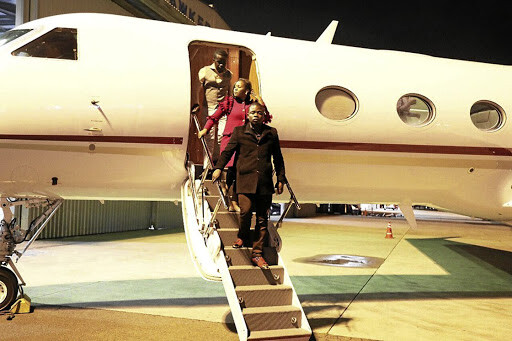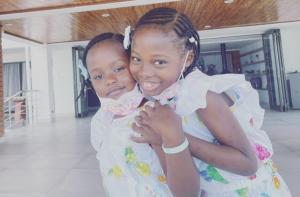
Malawi government has allowed Prophet Shepherd Bushiri to send his first born child, Israella Bushiri, to Kenya for a bone-marrow transplant.
The innocent child, 8 years old, was barred at the Kamuzu International Airport from leaving the country last week on Friday despite having clear medical documentation.
On the foiled journey, she was accompanied by three guardians, her sister Raphaella, cousin Esther Bushiri and grandmother (Mary Bushiri’s mother) Magdalena Zgambo. The three have also been allowed to travel with Israella.

A day after the Bushiris were restrained from leaving the country, Prophet Bushiri revealed that a warrant of arrest was issued for him and his wife. He escaped arrest because of an injunction that he obtained restraining the Malawi Police and Directorate of Public Prosecution in the country from effecting an arrest of him and his wife.
The two are fugitives wanted in South Africa for fraud and money laundering. They are currently fighting extradition to the rainbow nation. Hearing on the case is slated for this coming Friday in Lilongwe.
While details of Israella’s sickness have not been made public by the family, a letter from the Malawi Homeland Security Minister Richard Chimwendo Banda clearing the Bushiris to leave the country reveals that Israella is going to Kenya for bone marrow transplant.
Her bone marrow donor is her sister, Raphealla.
“I would like to confirm that Israella Bushiri [has] been referred to a specialist in Kenya upon examination of [her] condition which cannot be treated locally. [S]he will be accompanied by Raphaella Bushiri [who] will donate bone marrow to the patient”.
Their guardian in Kenya are cousin Esther and grandmother Magdalena Ndiwila Zgambo.
What is a Bone Marrow Transplant (Stem Cell Transplant)?
A doctor-approved patient information database from the American Society of Clinical Oncologys which is a professional organization representing physicians of all oncology sub-specialties who care for people with cancer details what constitute bone marrow sickness and transplant.
The database, Cancer.Net indicate that a bone-marrow transplant is a treatment required for people diagnosed with cancer.
Cancer.Net is the official website of the American Society of Clinical Oncology (ASCO) which is the world’s foremost organization of cancer physicians. The site provides easy-to-understand, up-to-date, reliable cancer information, reviewed and approved by oncology experts.
All content published by the site which was founded in 2002 “is subject to a formal peer-review process by the Cancer.Net Editorial Board, composed of more than 150 medical, surgical, radiation, and pediatric oncologists, physician assistants, oncology nurses, social workers, and patient advocates”.
According to the website, a bone marrow transplant is a medical treatment that replaces your bone marrow with healthy cells. The replacement cells can either come from your own body or from a donor.
A bone marrow transplant is also called a stem cell transplant or, more specifically, a hematopoietic stem cell transplant. Transplantation can be used to treat certain types of cancer, such as leukemia, myeloma, and lymphoma, and other blood and immune system diseases that affect the bone marrow.
What are stem cells? What is bone marrow?
Stem cells are special cells that can make copies of themselves and change into the many different kinds of cells that your body needs. There are several kinds of stem cells and they are found in different parts of the body at different times.
Cancer and cancer treatment can damage your hematopoietic stem cells. Hematopoietic stem cells are stem cells that turn into blood cells.
Bone marrow is soft, spongy tissue in the body that contains hematopoietic stem cells. It is found in the center of most bones. Hematopoietic stem cells are also found in the blood that is moving throughout your body.
When hematopoietic stem cells are damaged, they may not become red blood cells, white blood cells, and platelets. These blood cells are very important and each one has a different job:
Red blood cells carry oxygen throughout your body. They also take carbon dioxide to your lungs so that it can be exhaled.
White blood cells are a part of your immune system. They fight pathogens, which are the viruses and bacteria that can make you sick.
Platelets form clots to stop bleeding.
A bone marrow/stem cell transplant is a medical procedure by which healthy stem cells are transplanted into your bone marrow or your blood. This restores your body’s ability to create the red blood cells, white blood cells, and platelets it needs.
What are the different types of transplant?
There are different types of bone marrow/stem cell transplants. The 2 main types are:
Autologous transplant. Stem cells for an autologous transplant come from your own body. Sometimes, cancer is treated with a high-dose, intensive chemotherapy or radiation therapy treatment. This type of treatment can damage your stem cells and your immune system. That’s why doctors remove, or rescue, your stem cells from your blood or bone marrow before the cancer treatment begins.
After chemotherapy, the stem cells are returned to your body, restoring your immune system and your body’s ability to produce blood cells and fight infection. This process is also called an AUTO transplant or stem cell rescue.
Allogenic transplant. Stem cells for an allogenic transplant come from another person, called a donor. The donor’s stem cells are given to the patient after the patient has chemotherapy and/or radiation therapy. This is also called an ALLO transplant.
Many people have a “graft-versus-cancer cell effect” during an ALLO transplant. This is when the new stem cells recognize and destroy cancer cells that are still in the body. This is the main way ALLO transplants work to treat the cancer.
Finding a “donor match” is a necessary step for an ALLO transplant. A match is a healthy donor whose blood proteins, called human leukocyte antigens (HLA), closely match yours. This process is called HLA typing. Siblings from the same parents are often the best match, but another family member or an unrelated volunteer can be a match too. If your donor’s proteins closely match yours, you are less likely to get a serious side effect called graft-versus-host disease (GVHD). In this condition, the healthy transplant cells attack your cells.
If your health care team cannot find a donor match, there are other options.
Umbilical cord blood transplant. In this type of transplant, stem cells from umbilical cord blood are used. The umbilical cord connects a fetus to its mother before birth. After birth, the baby does not need it. Cancer centers around the world use cord blood. Learn more about cord blood transplants.
Parent-child transplant and haplotype mismatched transplant. Cells from a parent, child, brother, or sister are not always a perfect match for a patient’s HLA type, but they are a 50% match. Doctors are using these types of transplants more often, to expand the use of transplantation as an effective cancer treatment.
How does a bone marrow/stem cell transplant work?
The information below tells you the main steps of AUTO and ALLO transplants. In general, each process includes collecting the replacement stem cells, the patient receiving treatments to prepare their body for the transplant, the actual transplant day, and then the recovery period.
Often, a small tube may be placed in the patient’s chest that remains through the transplant process. It is called a catheter. Your health care team can give you chemotherapy, other medications, and blood transfusions through a catheter. A catheter greatly reduces the amount of needles used in the skin, since patients will need regular blood tests and other treatments during a transplant.
Please note that transplants are complex medical procedures and sometimes certain steps may happen in a different order or on a different timetable, to personalize your specific care. Ask your health care whether you will need to be in the hospital for different steps, and if so, how long. Always talk with your health care team about what to expect before, during, and after your transplant.
For more details about bone-marrow transplant, visit Cancer.Net















